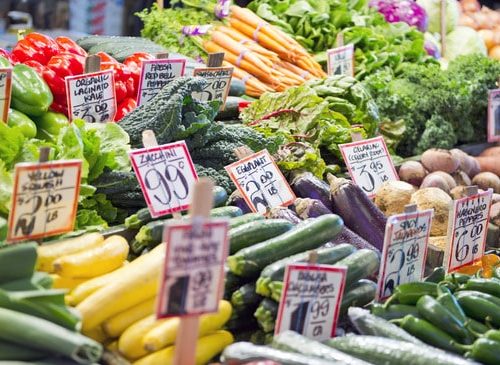How Meal Planning Can Help You Get Enough Fiber in Your Diet
Maintaining a healthy diet and lifestyle takes a lot of work, but one thing, in particular, can help you achieve the health goals you set for yourself: planning. For some people, planning comes naturally, but for others it takes some time and effort to make it a regular part of their lifestyle. Whether you’re scheduling specific days and times to get to the gym, looking at a restaurant menu before you arrive at the table, or writing out your grocery list in advance of the shopping trip, planning can help you make healthier choices when faced with road blocks that will otherwise get in the way.
Meal planning is one tool that is especially helpful to guarantee healthy, balanced meals are on the table throughout the week. It’s also a great way to ensure you’re meeting your nutrient needs on a daily and weekly basis. This is particularly helpful for certain nutrients like fiber, which many people have trouble getting enough.
Planning your meals in advance allows you to make sure you have the ingredients you need on hand in the fridge, freezer and pantry. For example, when you head to the kitchen for breakfast first thing in the morning, you’ll know that you have enough bran flakes and blueberries on hand if you thought through your breakfast meals ahead of time.
Stock your kitchen with fiber-rich foods that are quick and easy to add to any meal of the day. Here’s a checklist of fiber-rich foods, keeping in mind calorie count when selecting foods, to keep on pantry shelves that can be included for breakfast, lunch, dinner and snacks:
- Whole grains like barley, quinoa, oats, brown rice, whole wheat flour and white whole wheat flour
- Canned beans and legumes, including split peas and lentils
- Popcorn, nuts, and seeds, including almonds, pistachios, flaxseed, and chia seeds
- Dried fruit, especially prunes and dried figs
- Cereals, especially those with bran like wheat bran and oat bran
- Fresh and frozen fruit, especially pears, apples, berries, and avocado
- Leafy greens and cruciferous vegetables, including spinach, kale, cauliflower, broccoli, and Brussels sprouts
In addition to all the naturally fiber-rich foods, many foods these days are fortified with fiber. In particular snack foods like granola bars, crackers, pretzels, and even yogurts often have fibers added as seen in their ingredient lists. Grocery store shelves are lined with products, so the best way to ensure you’re getting those that are fiber-rich is to read the Nutrition Facts Panel and ingredient lists on food labels. Look for the inclusion of natural fibers like inulin, cellulose, maltodextrin, psyllium, and oat fiber to know where the fiber is coming from.
Once your kitchen is stocked with fiber-rich foods it’s much easier to come up with your menu for the week. Think through your schedule for the week to determine how many meals you will be eating at home and how many you will have time to cook or whether you need to rely on take-out for a night or two. Then get going jotting down each meal of the day and including as many fiber-rich foods and packaged products that you can into each day.
For example, start your morning with a bowl of oatmeal with berries and slivered almonds. For lunch, make a sandwich on whole grain bread and pair it with a baby spinach salad. Snack on a fiber-fortified granola bar or apple with peanut butter. For dinner, pair your protein of choice with a side of quinoa and sweet potatoes.
Just a little bit of planning can go a long way to helping you get enough fiber in your diet.
 Jessica Fishman Levinson, MS, RDN, CDN is a registered dietitian nutritionist and the founder of Nutritioulicious, a New York-based nutrition communications and consulting business with a focus on culinary nutrition. Jessica has extensive experience as a recipe developer, writer, editor, and speaker. She is the co-author of We Can Cook: Introduce Your Child to the Joy of Cooking with 75 Simple Recipes and Activities (Barron’s, 2011), the Culinary Corner columnist for Today’s Dietitian Magazine, and maintains the popular Nutritioulicious blog. Jessica is a paid contributor to the Calorie Control Council. Jessica is an active member of the Academy of Nutrition and Dietetics (AND) and various Dietetic Practice Groups of the AND, including Nutrition Entrepreneurs, Food and Culinary Professionals, and Dietitians in Business and Communications. Follow her out on Twitter @jlevinsonRD and check out her blog Nutritioulicious.
Jessica Fishman Levinson, MS, RDN, CDN is a registered dietitian nutritionist and the founder of Nutritioulicious, a New York-based nutrition communications and consulting business with a focus on culinary nutrition. Jessica has extensive experience as a recipe developer, writer, editor, and speaker. She is the co-author of We Can Cook: Introduce Your Child to the Joy of Cooking with 75 Simple Recipes and Activities (Barron’s, 2011), the Culinary Corner columnist for Today’s Dietitian Magazine, and maintains the popular Nutritioulicious blog. Jessica is a paid contributor to the Calorie Control Council. Jessica is an active member of the Academy of Nutrition and Dietetics (AND) and various Dietetic Practice Groups of the AND, including Nutrition Entrepreneurs, Food and Culinary Professionals, and Dietitians in Business and Communications. Follow her out on Twitter @jlevinsonRD and check out her blog Nutritioulicious.





